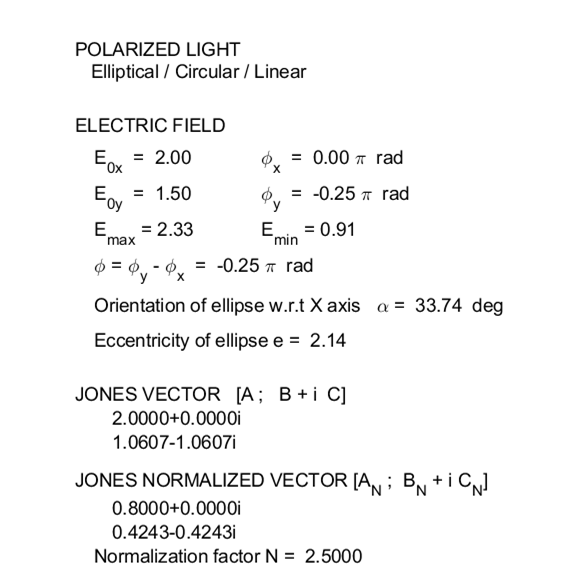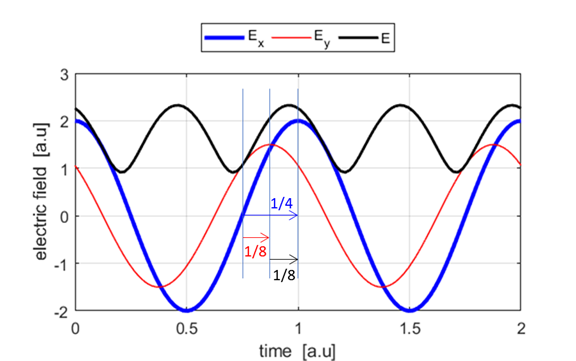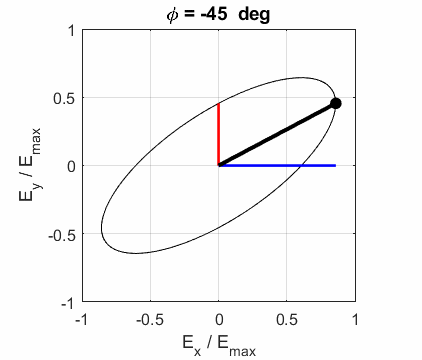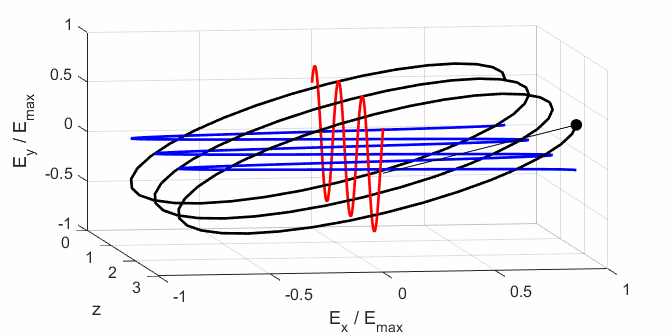|
NUMERICAL ANALYSIS
OF OPTICAL AND ELECTROMAGNETIC PHENOMENA POLARIZED LIGHT MATHEMATICAL
FOUNDATIONS Ian
Cooper matlabvisualphysics@gmail.com Matlab Script Download Directory op_005.m The Script op_005.m can be used
to model the any type of polarization. The animations of the electric field
vector can be saved as animated gif files (flag1 and flag2). In
the INPUT SECTION of the Script, you can enter the amplitudes of the electric
field components and their phase angles (flagP = 1) or
the Jones parameters (flag2 = 2). From the input values, the electric field (E,
Ex, Ey) as functions of time t and position z are
calculated. In any plane (z = constant), the electric field vector sweeps out
an ellipse with time (a straight line: linear polarization and a circle:
circular polarization are special cases of an
ellipse). The time evolution of the magnitude of the electric field is used
to find its maximum Emax and minimum Emin values and the angle switch flagP case 1 % Relative phase
difference of Ey w.r.t. Ex [rad]
phi = phiy-phix; % JONES VECTOR V and
Normalized Jones Vector VN
A = E0x;
B = E0y*cos(phi);
C = E0y*sin(phi);
V = [A; B + 1i*C];
N = sqrt(A^2 + B^2 + C^2);
AN = A/N; BN = B/N; CN = C/N;
VN = V./N; case 2
E0x = A;
phi = atan2(C,B);
phix = 0;
phiy = phi;
E0y = sqrt(B^2 + C^2);
V = [A; B + 1i*C];
N = sqrt(A^2 + B^2 + C^2);
AN = A/N; BN = B/N; CN = C/N;
VN = V./N; end % Time domain T = 1;
%
period of vibration [a.u.] w = 2*pi/T;
%
angular frequency of vibration [a.u.] t = linspace(0,T,nT); % time [a.u.] uT
= exp(-1i*w*t);
%
Wave function for time evolution % spatial Z domain k = 2*pi;
%
Propagation constant z = linspace(0,3,nZ); % Z domain grid
points uZ
= exp(1i*k*z);
%
Spatial Z wavefunction % Electric Field ECx
= E0x * exp(1i*phix); % Complex electric field
amplitudes ECy
= E0y * exp(1i*phiy); Ex = ECx
.* uT;
%
time dependent electric field components Ey
= ECy .* uT;
% Magnitude of electric field vector as a function
of time E
= sqrt(real(Ex).^2+real(Ey).^2); % Max
magnitude of electric field vector
Emax = max(E); % Min
magnitude of electric field vector Emin = min(E); % Index for
time when electric field vectro has max
magnitude
k = find(E == max(E),1); % Orientation
of major axis of ellipse w.r.t. X axis [deg]
alpha = atand(real(Ey(k))/real(Ex(k))); % Eccentricity
e
= sqrt(Emax^2 - Emin^2); op_003.m XY plane animation of a polarized electric field vector for an EM wave propagating in the +Z direction. The electric field is specified by its Jones Vector. POLARIZED LIGHT Light is a transverse wave, hence it can be polarized. In
the mathematical analysis of polarized light, we only need to consider the
electric field and so we can ignore the magnetic field in our description,
since the magnetic field can be determined from the electric field via
Maxwell’s equations. The electric field is a vector quantity, so we
need to specify both its magnitude and its direction. Consider a plane wave
propagating in the +Z direction. Then the oscillation of the electric and
magnetic fields must be in a XY plane with the electric field perpendicular
to the magnetic field. The instantaneous
Fig. 1. Instantaneous electric field vector The
electric field vector
Assuming a harmonic variation in the fields, the space and time dependence of the electric field components can be expressed as
where
We can define a complex amplitude and its X and Y components for the electric field
The actual values of the electric field and its components are found by taking the real parts of the complex functions. A convenient way thinking about polarized light is that it is a superposition of two linear polarized components vibrating along the X and Y axes. The classification
or state of the polarization depends upon the relative phase
Polarization state (mode) depends on: In an XY plane, the electric field vector sweeps out an
ellipse with time which is enclosed by a rectangle having dimensions
Increasing or decreasing the relative phase angle
STATES OF POLARIZATION
Anticlockwise rotation of the electric field vector in a XY plane
The term The electric field vector
sweeps out a circle in an anticlockwise
sense as viewed head-on looking back along the Z axis. This is referred
to as left circular
polarized light (positive helicity). For a fixed value of t,
the electric field vector describes a spiral on the surface of a cylinder of
radius
Clockwise rotation of the electric field vector in a XY plane
The term The electric field vector
sweeps out a circle in a clockwise sense
as viewed head-on looking back along the Z axis. This is referred to as right circular polarized light
(negative helicity). For a fixed value of t, the electric
field vector describes a spiral on the surface of a cylinder of radius
·
Elliptical
polarized
major axis of ellipse aligned along the X axis or Y axis
JONES VECTORS We can employ a matrix technique developed by R.C. Jones (1941) to give a mathematical description of polarization. A two-element column vector is used to represent light in various modes of polarization. The state of polarization of light is completely
determined by the relative amplitudes and relative phase of the components
The X component element of the Jones vector is taken as a real quantity and we can always multiply the column vector by suitable quantity to achieve this. Since the state of polarization only depends upon the relative amplitudes, the multiplication of the column vector by a constant does not change the state of polarization angle. The most general case for the Jones Vector is expressed as
where A, B and C are real constants. The normalized Jones
vector is defined such that
So, given the Jones Vector expressed in terms of A, B
and C we can calculate the electric field
components and the relative phase
or given the electric field components, we can calculate
the Jones parameters A, B
and C EXAMPLE op_005.m We can illustrate the power of using the Matlab Script op_005.m to investigate the properties of the state of polarization for elliptical light specified by the input values E0x = 2; E0y = 1.5; phix
= 0; phiy
= -pi/4; flagP
= 1;
Fig. 2. A Figure Window is used to give a summary of the parameters for the simulation of the propagation of a polarized EM wave. Note: Emax is calculated numerically. The greater the number of time steps the greater the accuracy of the value for Emax. The correct value for Emax is 2.50 and so the value Emax = 2.33 is only an approximation.
Fig. 3. The time evolution of the electric
field for two cycle. The black curve shows the variation in the magnitude of the electric field
Fig. 4. Animation of the elliptical polarized
light oriented at an angle
Fig. 5. Animation of the electric field
propagating in the +Z direction. The blue curve shows the X component
|
|
|












